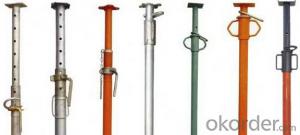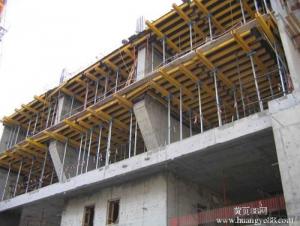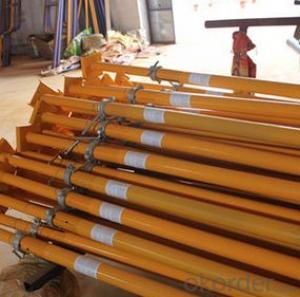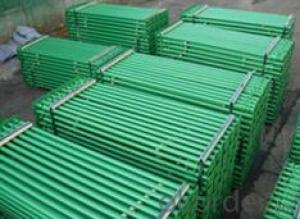Scaffolding Steel Props / Shoring Props for Scaffolding System
- Loading Port:
- China main port
- Payment Terms:
- TT OR LC
- Min Order Qty:
- 1000 pc
- Supply Capability:
- 1000000 pc/month
OKorder Service Pledge
OKorder Financial Service
You Might Also Like
Product information:
Model Number: GTJ-P003
Name: Q235 High Quality Steel Slab Props
Material: Q235
Thickness: 1.6mm to3mm or as your requirements
Surface Treatment: as per requirements
Standard: use your standard or international standard
Dimension: Light duty 40-48mm, MID Duty 48-56/58mm, Heavy duty 48-60mm


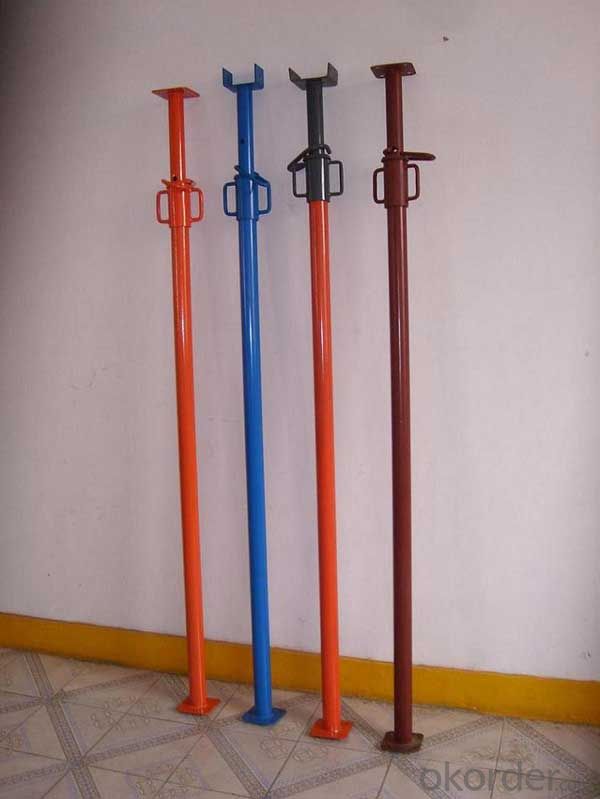
Characteristics:
1. Reliable performance
2. Corrosion resistance
3. Durable finish standards
Functions
It is used for construction supporting, timber, formwork, concrete slab and so on. It is very easy and reliable to use
Why Choose Us
1. We are experienced manufacturer in Hebei with more than 4 years experience and cooperating with more many countries.
2. We supply qualified products which are certified by SGS and ISO9001:2008. Strict QC to make sure your profit.
3. Timely delivery can be guaranteed because we have a factory which covers an area of 30000sqm and its daily output is more than 50 tons.
4. A competitive price can be offered because we are a professional manufacturer of scaffolding with an advantage on cost-controlling & production management.
- Q: What are the differences and similarities between the support of wood, steel, and steel?
- Steel and wood support is a part of the steel used to support the structure of wood, in some cases, the main force components with steel support, secondary or auxiliary parts of the force with wood support. Take the advantages of wood and steel, that is convenient for construction and cost savings.The same point of steel support, steel support, steel or wood.
- Q: Are there any weight restrictions for using steel props?
- Yes, there are weight restrictions for using steel props. The weight restrictions depend on the specific type and size of the steel prop being used. Steel props are commonly used in construction and temporary support structures to provide load-bearing capacity and stability. These props are designed to handle specific weight loads based on their dimensions, material strength, and load-bearing capacity. Exceeding the weight restrictions can lead to structural failure, compromising the safety of the construction site or temporary support system. It is crucial to consult the manufacturer's guidelines and specifications to ensure that steel props are used within their designated weight limits. Additionally, professional engineers and contractors should assess the load requirements and make appropriate calculations to determine the proper size and number of steel props needed for a specific application.
- Q: Can steel props be used in bridge repair projects?
- Yes, steel props can be used in bridge repair projects. Steel props are commonly used in construction and engineering projects, including bridge repairs, to provide temporary support and stability during the construction or repair process.
- Q: Can steel props be used in the installation of temporary water or sewage pipelines?
- Yes, steel props can be used in the installation of temporary water or sewage pipelines. Steel props are commonly used in construction projects to provide support and stability to structures during installation or repair work. In the case of temporary water or sewage pipelines, steel props can be used to hold the pipelines in place and prevent them from collapsing or shifting. Steel props are sturdy and can withstand the weight and pressure exerted by the pipelines. Additionally, they are adjustable in height and can be easily installed and removed, making them suitable for temporary installations. Overall, steel props are a reliable and effective solution for ensuring the proper installation and stability of temporary water or sewage pipelines.
- Q: Are steel props commonly used in construction projects?
- Yes, steel props are commonly used in construction projects. They are adjustable steel columns that provide temporary support for various construction elements such as walls, beams, and slabs. Steel props are widely used due to their strength, durability, and versatility in supporting heavy loads during the construction process.
- Q: Can steel props be used for temporary support during machinery installation?
- Indeed, temporary support during machinery installation can be provided by steel props. Commonly adjustable, these props can be extended to the desired height in order to adequately support the machinery. Due to their strength and sturdiness, steel props are well-suited for offering temporary support during installation procedures. Furthermore, their design enables them to endure heavy loads, thus rendering them a reliable choice for supporting the weight of machinery during the installation process. Nevertheless, it is crucial to ensure the proper installation and securing of steel props to prevent any accidents or instability. Consulting professionals or engineers is also highly recommended to determine the appropriate size and type of steel props necessary for the specific machinery installation.
- Q: How do you ensure the stability of a steel prop?
- To ensure the stability of a steel prop, several factors need to be considered and addressed. First and foremost, it is crucial to ensure that the prop is designed and manufactured according to industry standards and guidelines. This includes using high-quality materials, following proper fabrication techniques, and conducting thorough quality control checks. In addition to the design and manufacturing aspects, proper installation is key to ensuring the stability of a steel prop. The prop should be placed on a solid and level surface to prevent any tilting or shifting. It is also essential to properly secure the prop to the structure it is supporting, using appropriate fasteners or connectors. Regular inspections and maintenance are crucial for the long-term stability of a steel prop. Periodic checks should be conducted to identify any signs of damage, wear, or deterioration. Any issues should be promptly addressed, either through repairs or replacements, to prevent further instability or potential failure. Furthermore, proper load distribution is vital for the stability of a steel prop. The load should be evenly distributed across the prop, and its capacity should not be exceeded. Overloading a prop can lead to excessive stress and strain, compromising its stability and potentially causing it to collapse. Lastly, it is essential to consider the environmental conditions and potential external forces that can affect the stability of a steel prop. Factors such as wind, seismic activity, or nearby construction activities should be taken into account. Adequate precautions, such as bracing or additional support, may be necessary to ensure the prop remains stable under these conditions. Overall, ensuring the stability of a steel prop requires a combination of proper design, installation, maintenance, load management, and consideration of external factors. By following industry standards, conducting regular inspections, and addressing any issues promptly, the stability of a steel prop can be effectively maintained.
- Q: Do steel props require any additional support at the base?
- Yes, steel props do require additional support at the base. The purpose of adding support at the base is to ensure stability and prevent any potential structural failures. This is especially important when steel props are used to support heavy loads or are subject to significant lateral forces. Additional support at the base can be provided by using a suitable base plate or a load-bearing platform that is properly designed and installed. These supports help distribute the load evenly and provide a solid foundation for the steel props, preventing them from sinking into the ground or tipping over. Furthermore, it is essential to consider the ground conditions and terrain where the steel props are being used. In some cases, additional measures like ground reinforcement or anchoring may be required to ensure adequate stability and prevent any potential accidents. Overall, providing additional support at the base of steel props is crucial for maintaining the safety and integrity of the structure they are supporting. It is important to follow the manufacturer's guidelines and consult with structural engineers to determine the appropriate support required for each specific application.
- Q: Are steel props suitable for use in tunnel construction?
- Steel props are indeed suitable for use in tunnel construction. Their strength and durability make them a popular choice in construction projects, especially tunnel construction. They offer support and stability to the tunnel walls and roof, ensuring the safety of workers and the successful completion of the project. The load-bearing capacity of steel props is well-known, enabling them to withstand heavy loads, which is particularly beneficial in tunnels with high amounts of earth and rock pressure. Moreover, steel props are adjustable, allowing for easy installation and flexibility in accommodating various tunnel sizes and shapes. In summary, steel props are a reliable and practical option for tunnel construction, providing the necessary support and stability required for the project.
- Q: Can steel props be used for supporting temporary structures during disaster relief efforts?
- Yes, steel props can be used for supporting temporary structures during disaster relief efforts. Steel props provide sturdy and reliable support, making them suitable for holding up temporary structures such as tents, shelters, or makeshift medical facilities in disaster-stricken areas. The strength and durability of steel make it a preferred choice for ensuring the stability and safety of structures in challenging environments.
Send your message to us
Scaffolding Steel Props / Shoring Props for Scaffolding System
- Loading Port:
- China main port
- Payment Terms:
- TT OR LC
- Min Order Qty:
- 1000 pc
- Supply Capability:
- 1000000 pc/month
OKorder Service Pledge
OKorder Financial Service
Similar products
Hot products
Hot Searches
Related keywords

